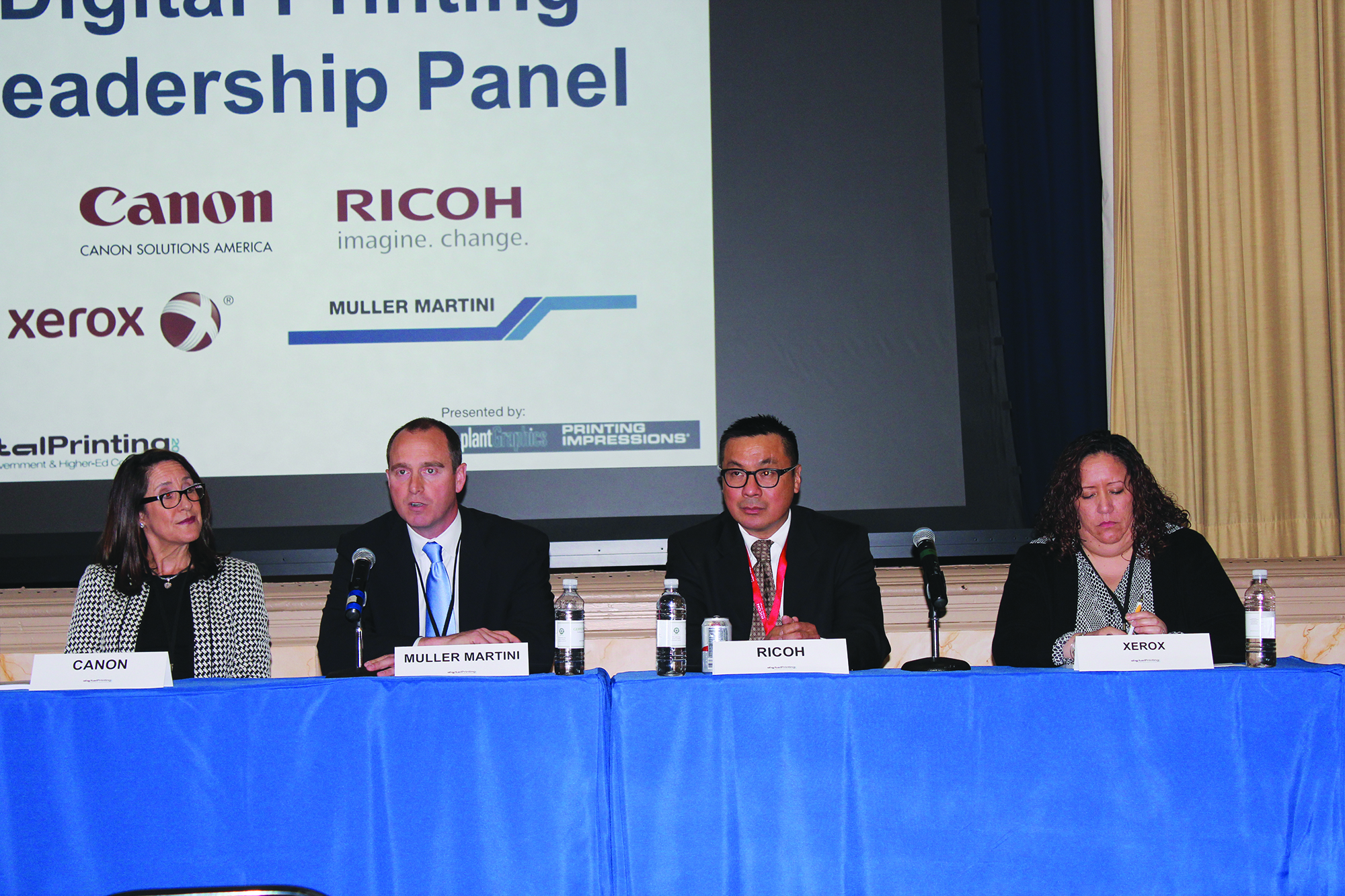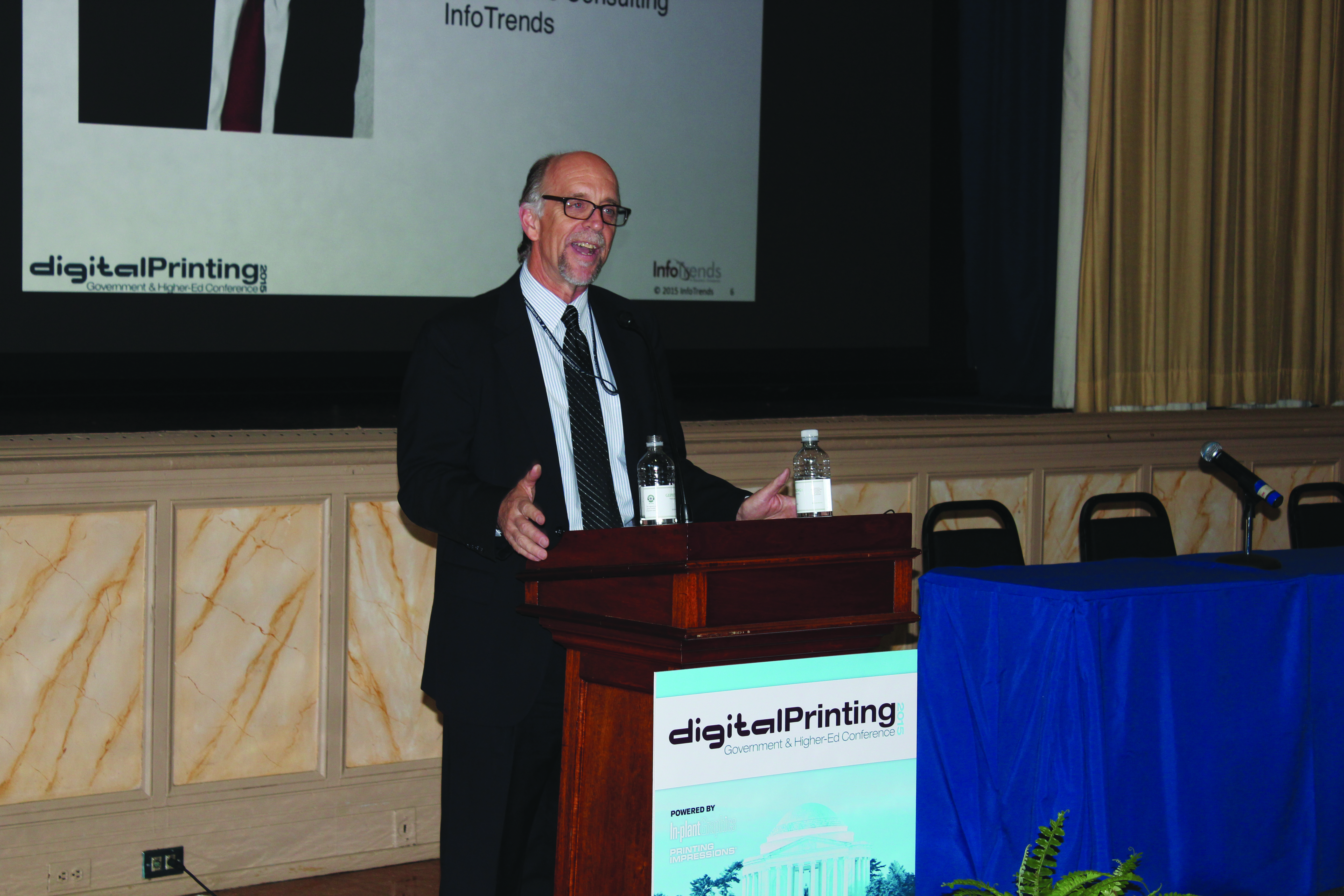
Managers traveled from across the country to the conference. From left: Mike Lincoln, Colorado State Printer; Jerry Hill, California State Printer; Dave Leonard, manager of Printing and Multimedia Services at The World Bank Group; and Tammy Golden, director of Printing and Media Services for the State of Tennessee.
Inside an elegant copper-toned building near Washington’s Capitol Hill, the preliminary version of the Emancipation Proclamation was once set to type, the Watergate transcripts were printed and multiple declarations of war were produced.
On Thursday, May 14, approximately 70 in-plant managers from across the country, plus dozens of other printers, vendors and consultants, passed through the same doors of the Government Publishing Office, to spend a day learning and networking at the historic printing plant, also the largest in-plant in the United States.
It was the inaugural Digital Printing in Government and Higher-Ed Conference, an event organized and hosted by In-plant Graphics and sponsored by Canon Solutions America, Ricoh, Muller Martini, and Xerox. Other supporters included EFI, HP, Rochester Software Associates, Kodak, Presstek, International Paper and Roland.
The event was held inside GPO’s Harding Hall, named after accomplished printer and former president Warren G. Harding. It drew in-plant managers from agencies around the nation’s capital, as well as GPO’s top brass: GPO Director Davita Vance-Cooks and Deputy Director Jim Bradley were both there. Three state printers—from Colorado, California and Tennessee—also attended, as did in-plant managers from universities, local governments and other organizations around the country.
“It was a great experience, meeting so many of my peers, whom I may not have had the chance to meet, in a small setting like this,” remarked Richard Peterson, manager of Office Services and Procurement at The Metropolitan Museum of Art, in New York. “The subjects and the people who spoke were very good and interesting and informative.”
“It’s refreshing to get together with other in-plant managers. I’m always reminded of how much we have in common,” observed Tammy Golden, director of the State of Tennessee’s Division of Printing and Media Services. “I also look forward to hearing from the industry experts, as well as the vendors, to get the latest stats on the state of the industry and what’s in our future. The icing on the cake was having it hosted at the GPO and getting to hear from their staff. It was well worth the trip.”
As part of the conference, attendees had the chance to tour GPO’s impressive facility and see its new Timson ZMR (Zero Makeready) web press in operation.
In-plants Always Welcome
To get things started, IPG Editor Bob Neubauer welcomed the large crowd of in-plant managers. He introduced GPO Chief of Staff Andrew Sherman, who told the crowd that in-plants may often have to earn the respect of the their parent companies, but at the GPO, they’d always be warmly welcomed.
“Here, you’ll get nothing but love,” he said.
Attendees visited the sponsors’ displays during a break. Key conference sponsors were Canon Solutions America, Ricoh, Muller Martini, and Xerox. Other supporters included EFI, HP, Rochester Software Associates, Kodak, Presstek, International Paper and Roland.
After Sherman’s salutation and introduction to the GPO, Howie Fenton, an associate director of operations consulting for InfoTrends, took the podium. In the first of two presentations led by Fenton during the event, he focused on best practices for in-plants and strategies for growth. In particular, Fenton stressed the importance of benchmarking.
He explained that often, the number one metric used to measure success in a printing operation is the amount of sales per employee. But, Fenton said, in-plants vary in size and scope, and a better way to measure an in-plant’s worth is to take a look at similar operations.
“What’s going to determine success is your -ability to prove your value,” Fenton explained. “How? By comparing your performance against others in the industry.”
Fenton also noted that print spending in government and higher-ed is trending downward, so in-plants need to focus on two important initiatives: decreasing the cost of manufacturing print and offering more value-added services. To bring about the first, he said, in-plants should add process automation software, such as Web-to-print, MIS, workflow and color management. To know which value-added services to consider, he said, listen to the voice of your customer.
- Chapters
- descriptions off, selected
- captions settings, opens captions settings dialog
- captions off, selected
This is a modal window.
The Video Cloud video was not found.
Beginning of dialog window. Escape will cancel and close the window.
End of dialog window.
This is a modal window. This modal can be closed by pressing the Escape key or activating the close button.
This is a modal window. This modal can be closed by pressing the Escape key or activating the close button.
Get Growing
Throughout the day, several speakers discussed ways in-plants can expand on the services they provide to their parent organizations, and thus increase their value to the company. One of the services discussed at length was Web-to-print and how adding software automation can provide several benefits to in-plants. David Leonard and Les Barker of The World Bank Group’s Printing and Multimedia Services department made the short trip from their Maryland-based operation to discuss how they use Web-to-print.
Leonard explained that the way people consume information now is through an “omnichannel” system. This means information is delivered across all channels, on many types of devices. Barker stated that the in-plant has developed an understanding of this omnichannel need and has utilized Web-to-print technology to not only automate the printing process, but also communicate more with the customer.
Through the World Bank Group’s Web-to-print storefront, the in-plant can suggest related products to customers, add augmented reality elements to printed products, and store videos that are available for download, Barker said.
“When you combine services with multimedia and AV, that can equal added value,” he said.
Adding Value
Value-added services was also one of the topics touched on by IPG’s Neubauer in his presentation. He showed examples of new services in-plants are now offering, such as shredding, garment printing, 3D printing, framing and wide-format printing, which he noted is on the rise in both government and higher-education in-plants. He pointed to several government in-plants that are producing decorative wall art and gallery wraps to spruce up offices and government buildings. He also detailed other trends in the in-plant market using IPG research, and showed how the government and higher-ed sectors compare with the overall in-plant industry.
Best Practices
Though adding services and adding value are essential considerations for in-plants, the conference also touched on ways to improve operations through better training and decision-making.
For example, Fenton explained that many in-plants claim to cross-train their employees, but frequently fall short of having substitutes readily available to step in and take over when the main operator is out.
One way to solve this problem, Fenton suggested, is to create a video library on YouTube showing operators running a piece of equipment. Instead of having an employee learn a process and then have to relearn it some time down the road when they need to fill in, these videos can be a quick reference tool.
“You can videotape people doing that task and create a library,” Fenton said. “Then, if that person goes on vacation, you can just pull up the video library.”
Audience members also heard from Sandra MacAfee, GPO’s deputy managing director of customer services, on procurement strategies and how to get the best value when buying printing.

The Digital Printing Leadership Panel gave the top conference sponsors a chance to explain how their solutions can help in-plants succeed. From the left: Sheri Jammallo (Canon Solutions America); Mike Wing (Muller Martini); Ed Wong (Ricoh USA); and Lucy Perez (Xerox).
MacAfee explained that several factors go into a procurement decision, beyond just a low price. GPO also looks at whether the vendor bid according to specifications, if the quote was received on time, if it achieves the necessary quality level, and if there was a required test that needed to be passed.
“We don’t just see who’s low and go with that,” MacAfee stated.
The conference included plenty of time to talk with the vendors at their exhibit areas, and for attendees to meet one another and exchange information. A panel discussion with representatives from Ricoh, Canon, Xerox and Muller Martini covered some of the new digital printing and binding capabilities being offered. It was all very helpful in preparing managers for the changes ahead so they can properly retool their in-plants.
“I came into this conference knowing nothing about production inkjet, and now it’s on my radar. Well done,” remarked attendee Sean Carroll, the interim director of Vanderbilt University Printing Services. He said he appreciated the opportunity to learn about creative ways to improve his in-plant.
“Change is a way of life for printers these days, and we are feeling this pressure to innovate very acutely in the in-plant segment,” Carroll said. “Holding a forum like IPG’s Digital Printing 2015 conference was a great way to share best practices, success stories and emerging technologies in the printing industry. As the new director of a university in-plant, this event could not have come at a better time for me and my team.”
Related story: New IPG Video Shows Government, Higher-Ed Conference

Cory Francer is an Analyst with NAPCO Research, where he leads the team’s coverage of the dynamic and growing packaging market. Cory also is the former editor-in-chief of Packaging Impressions and is still an active contributor to its print magazines, blogs, and events. With a decade of experience as a professional journalist and editor, Cory brings an eye for storytelling to his packaging research, providing compelling insight into the industry's most pressing business issues. He is an active participant in many of the industry's associations and has played an essential role in the development of the annual Digital Packaging Summit. Cory can be reached at cfrancer@napco.com














